As an Amazon Associate, we earn from qualifying purchases with no additional costs for you.
Knife sharpening is the aspect of knife ownership that causes the most apprehension, especially for a new knife owner. Many sharpening methods and modern gadgets are available, making the choice of knife sharpener complicated. We will help to simplify your choice by comparing the various knife sharpening methods.
Whetstones are the best choice over manual or electric sharpeners, but they take time to master. Whetstones are less aggressive and offer more versatility in the sharpening angles and the type of knives that can be sharpened. Manual and electric sharpeners are suitable in some circumstances.
The abundance of sharpening solutions available adds layers of complexity to the choice of knife sharpener. Why are whetstones considered the best choice, and should you opt for this method, or are manual or electric sharpeners suitable?
If you are interested in checking out the best whetstones for your knives we recommend (and personally use) you can find them by clicking here (Amazon link).

Whetstone And (Electric) Sharpener: Short Introduction
Sharpening your knives is a crucial part of knife maintenance and will affect the usability and longevity of your knives.
Making the wrong choice in knife sharpeners, using a knife sharpener incorrectly, or using the wrong method on the wrong knife can destroy an expensive knife or result in a sub-standard edge.
Understanding the importance of correct sharpening and the consequences of getting it wrong causes many knife owners to approach this topic with some trepidation.
Many high-end knife owners are adamant that whetstones are better than any other knife sharpener. While this perception is true, it does not mean that other knife sharpeners do not have relevance or should not be considered in certain circumstances.
Whetstones
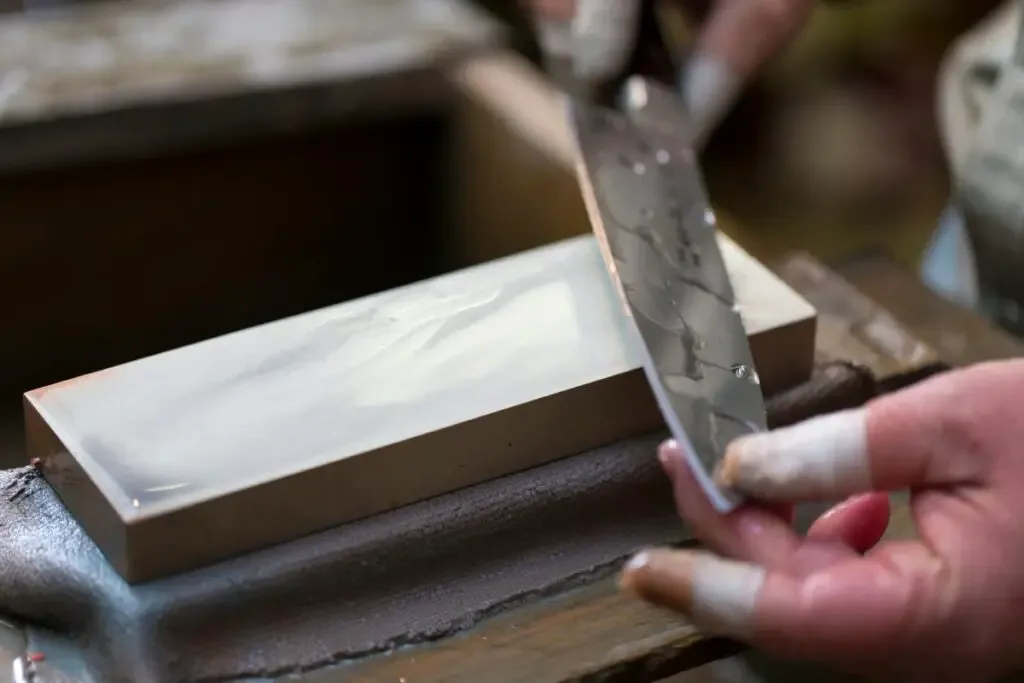
Whetstones are the quintessential knife sharpening tools that every knife owner should consider as the primary sharpening method for their knives.
Many knife owners are adamant that whetstones should be the only knife sharpening choice, and while you certainly get a great edge on a knife with a whetstone, it can be equally detrimental to your knife if you don’t know how to use a whetstone properly.
The advantages of sharpening with a whetstone include the following.
- Provides the sharpest edge. Whetstones come in multiple grit levels, allowing the cutting edge to be sharpened to the desired level.
- Whetstones provide greater angle control. You control the angles and the edge that can be established on the blade’s edge.
- Edge repair can be done on a whetstone. A whetstone is not only for sharpening but lower grit level stones can be used to repair a knife’s chipped or damaged cutting edge.
- Whetstones are suitable for a wider range of knives. Whetstones can be used on any quality knife, with any steel type, and achieve good results. The only blade not suitable for whetstone sharpening is a serrated-edge knife.
- Whetstones are gentler on a knife. Sometimes, the knife’s edge simply needs a touch-up, and the appropriate grit can be used for the intensity of sharpening required.
While whetstones are the best option for sharpening, they have some disadvantages. It is easy to mess up a knife on a whetstone if you are not experienced with this sharpening method, and it takes time to master this method and become competent.
TIP: If you are interested in buying a whetstone, we recommend buying one of the options in the table below. We personally use these whetstones when sharpening our knives:
| Usage | Grit Type | Best Option |
|---|---|---|
| Fixing stone | 320 grit | Shapton Kuromaku 320 |
| Establishing the Edge | 400 grit | Naniwa Chosera 400 |
| Sharpening Stone | 600 grit | Naniwa Chosera 600 |
| Sharpening Stone | 800 grit | Naniwa Chosera 800 |
| Finishing Stone | 1000 grit | Suehiro CERAX |
| Polishing Stone | 2000 grit | Shapton Kuromaku 2000 |
| Polishing Stone | 5000 grit | Shapton Kuromaku 5000 |
| Extra Polishing Stone | 8000 grit | Shapton Kuromaku 8000 |
| Mirror Polishing Stone | 12000 grit | Shapton Kuromaku 12000 |
Manual Sharpeners
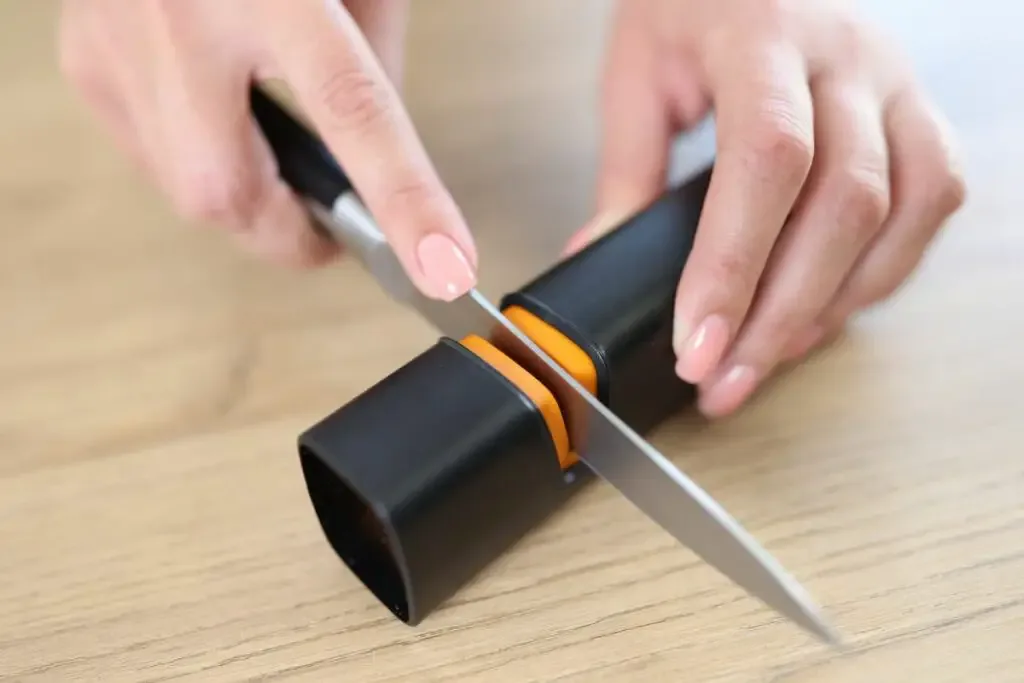
Manual sharpeners can be sharpening systems or pull-through sharpeners and can be a good alternative to whetstones in some circumstances.
Pull-through sharpeners are appropriate when you know the angle on the blade’s edge since most pull-through sharpeners have fixed angles.
Manual sharpening systems can have variable angle sharpening and use similar principles to whetstone methods but with less risk of error due to the guidance of the system mechanism.
Manual sharpeners are suitable for knives with a specific angle on the bevel and for touching up the sharp edge. Most manual sharpeners are not suitable for fixing a damaged edge but rather for basic sharpening only.
The main drawcard for manual sharpeners is their portability. It is easier to take a pull-through manual sharpener into the wilderness, on a job site, or on a campsite. Consequently, this type of sharpener is popular for hunting knives, bushcraft knives, and camp knives.
Pull-through sharpeners can be used on lower-end kitchen knives, but they are unsuitable for high-end, expensive knives.
The coarse abrasive in most manual pull-through sharpeners will wear the knife metal away faster than a fine grit stone. As a result, your knives will not last as long when they are sharpened regularly on a manual sharpener.
Electric Sharpeners
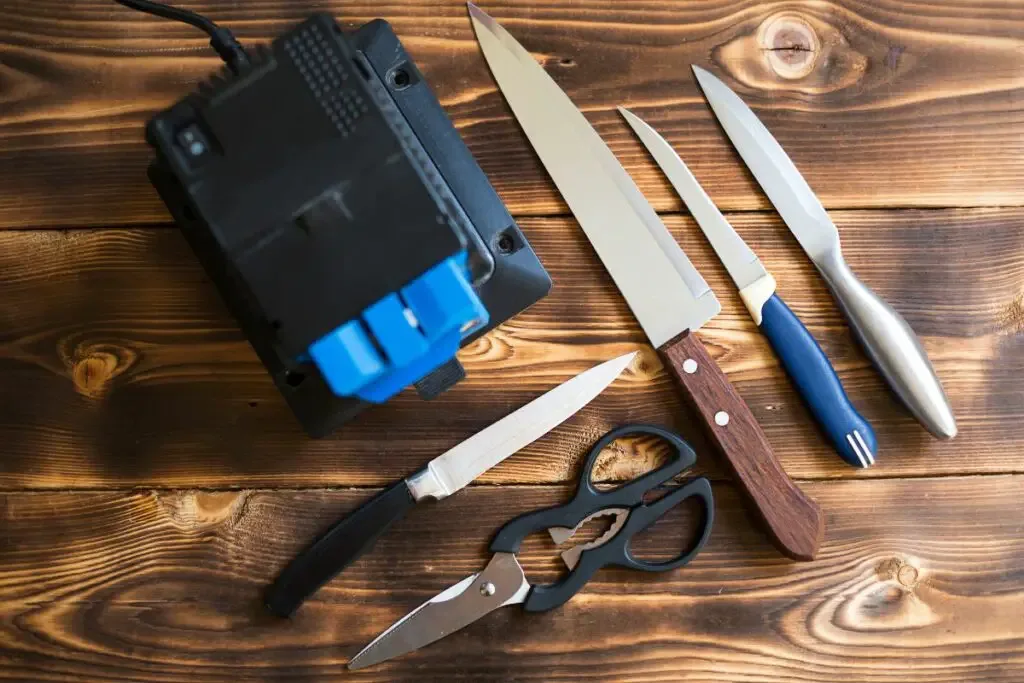
Electric sharpeners are essentially pull-through manual sharpeners with a motor that moves the abrasive surface across the blade’s edge. The advantage of this is a fresh part of the abrasive contacts the blade edge without metal particles or swarf, reducing the effectiveness of the abrasive.
Less pressure is required when sharpening the knife, as the machine usually controls the contact of the abrasive against the surface of the steel.
Electric sharpeners are easy to use and do not require much expertise to sharpen a knife. The limitations are that the sharpeners have limited edge angle options, and if you sharpen a high-end knife on an electric sharpener, you can damage the edge.
Some knife owners prefer electric sharpeners because of their convenience and ease of use. However, the abrasives on electric knife sharpeners are usually limited to one or two grit levels, making them harsh on the steel. This shortens the life of the knife by wearing the steel away faster than using an appropriate whetstone.
TIP: This is why we are always on the lookout for easier ways to keep our knives sharp. Can electric sharpeners fill this role, or do they ruin knives? Find out the answer in the article below:
Explained: Do (Electric) Knife Sharpeners Ruin Knives?
Is A Whetstone Better Than A (Electric) Sharpener?
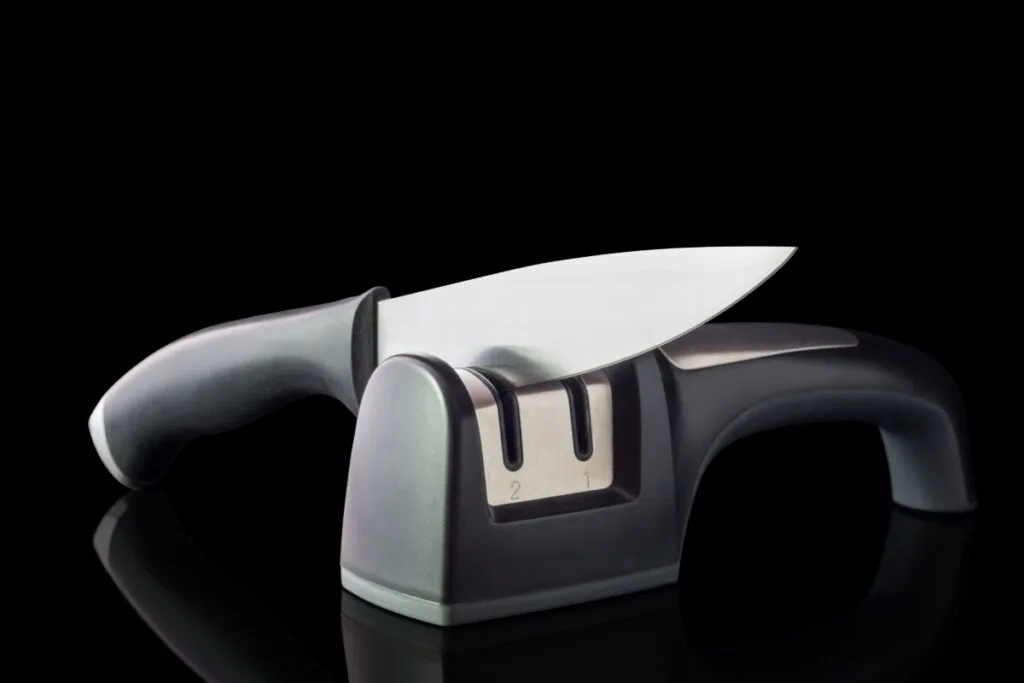
Beginner knife owners are often in a dilemma as to which knife sharpening system to use when they purchase their first good-quality knife.
Most knife makers and experienced knife owners recommend a whetstone over any other type of knife sharpener.
We will compare a whetstone with a manual sharpener and an electric sharpener to determine which method is best suited to the type of knives you have and how you use your knives.
Whetstone vs. Manual Sharpener Comparison
We have briefly discussed what a whetstone and a manual sharpener are, how they work, and their best uses for sharpening. Comparing whetstones to manual sharpeners will further clarify which option best suits your needs.
| Feature | Whetstone | Manual Sharpener |
|---|---|---|
| Convenience | Whetstones are bulky, and multiple stones are required to perform a thorough sharpening. | Manual sharpeners are portable and easier to store and carry. |
| Ease of use | Difficult to use and a steep learning curve to establish a professional edge. | Easy to use without much knowledge of knife edge geometry |
| Speed | Depending on the damage to the knife edge and the operator’s proficiency, it can take from 5 minutes to touch up an edge to 15 or 30 minutes to restore a knife edge. | Most manual sharpeners can re-establish an edge on a knife with 4 to 6 pulls of the knife through the sharpener, which takes less than a minute. |
| Level of sharpness | Extreme hair-splitting, long-lasting sharpness. | Average, mediocre sharpness that does not last long. |
| Versatility | Edge bevel angles can be adjusted for the type of knife and its function. Single and double bevel knives can be sharpened. | Manual sharpeners are limited edge bevel angles, usually one or two-angle options. |
| Aggressiveness | The appropriate grit can be selected depending on the amount of work needed on the knife’s edge. This promotes less material removal, lengthening the knife’s lifespan. | Very abrasive on the knife, removing a lot of material from the knife’s edge with each sharpening. |
| Suitability | Only suitable for quickly touching up a knife edge in the field and is not suitable for thin kitchen knives or single bevel knives. | Only suitable for quickly touching up a knife edge in the field and is not suitable for thin kitchen knives or single-bevel knives. |
TIP: Correct use and storage of your whetstones will contribute to protecting and preserving them. Find out the best whetstone holders and storage boxes in the article below:
Buyer’s Guide: The Best Whetstone Holders & Storage Boxes
Whetstone vs. Electric Sharpener Comparison
A set of whetstones is the best choice for sharpening knives, but electric sharpeners offer convenience and ease of use that make them attractive to many people who find whetstone sharpening intimidating.
If you are leaning toward using an electric sharpener, let’s see how they stack up against the whetstone alternative!
| Feature | Whetstone | Electric Sharpener |
|---|---|---|
| Convenience | Whetstones are messy, require more space, and can be cumbersome to store when not in use. | Electric sharpeners are more convenient, create less mess, and are easily stored in a kitchen cupboard or on the counter. |
| Ease of use | Whetstones take time to master, but a professional edge can be established on your knives once the technique is mastered. | Electric sharpeners are easy to use with no specialist knowledge of knife edge bevels and mastery of difficult techniques required. |
| Speed | Limited angle options usually limit the electric sharpener to double-bevel, thin kitchen knives. | Five minutes to sharpen a knife and 15 to 30 minutes to repair an edge. |
| Level of sharpness | Extremely sharp. | Very sharp |
| Versatility | If a diamond abrasive is used and the mechanism is spring-mounted to prevent excess pressure, medium wear is affected on the blade. | Any knife, including expensive knives and specialist knives, can be sharpened. Single-bevel knives can also be sharpened on whetstones. Serrated knives cannot be sharpened on whetstones. |
| Aggressiveness | Produce the least wear on a knife during sharpening. | If a diamond abrasive is used and the mechanism is spring mounted to prevent excess pressure, medium wear is affected on the blade. |
| Suitability | Suitable for all knives, from basic kitchen knives to expensive specialist knives, bushcraft knives, and pocket knives. Not suitable as a portable sharpening option. | Not suitable for Japanese kitchen knives, single bevel knives, or thick blade knives such as bushcraft knives. Limited portability – electricity is required to run the sharpener. |
TIP: Selecting the right type of sharpener to use on your knives is not as easy as it may seem at first. Check out the complete guide on how to choose the best sharpener in the article below:
Electric Vs. Manual Knife Sharpeners: 5 TIPS How To Choose
The Best Sharpening Options For Your Knives
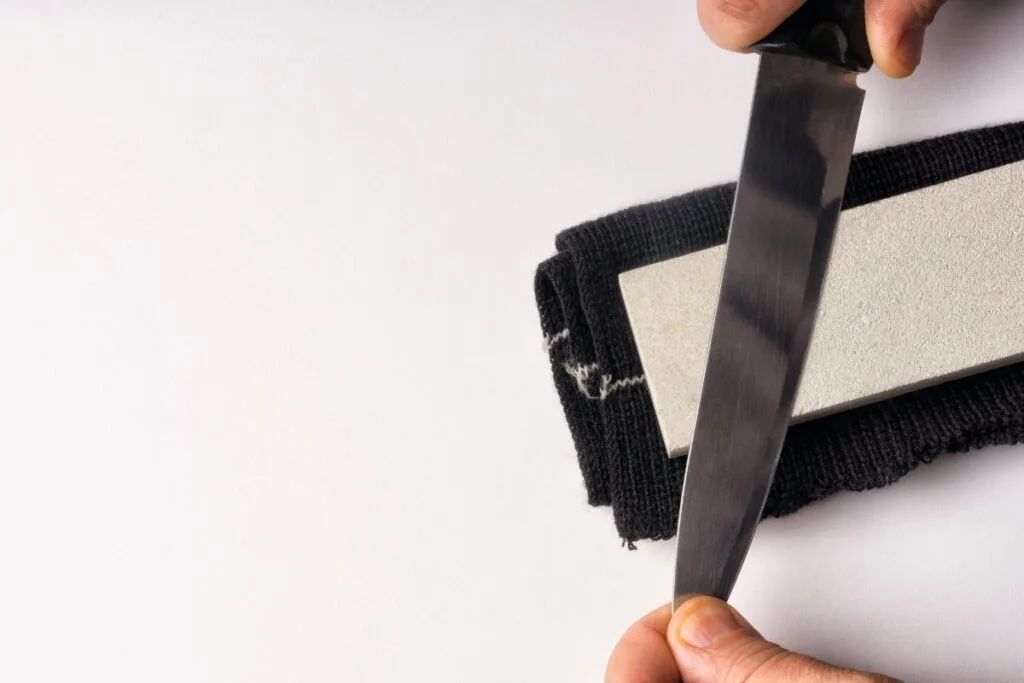
Even though whetstones are the best sharpening option for your knives, they are not always the most suitable option for some people.
Consequently, there will always be a place for good quality whetstones, manual sharpeners, and electric sharpeners.
To help you select the best sharpener of your choice, we have selected sharpeners in each category that we recommend that will offer a good sharpening experience.
The Best Whetstone
Shapton is a company specializing in making top-quality whetstones for sharpening top-quality knives. If you spend much time around knife people, you will hear the name Shapton frequently in conversations about sharpening.
The whetstones produced by Shapton are regarded as some of the best you can buy, and this Shapton Ha No Kuromaku Ceramic Whetstone set (Amazon link) is no exception!
The whetstones are all ceramic stones, which provide an excellent sharpening experience, with good feedback to the user to feel the knife edge on the stones. Water is the only lubricant you need on these ceramic stones, so there is no need to worry about an oily mess as with oil stones.
The set comes with three grit level stones: a course 320 grit stone, a medium 1000 grit stone, and a fine 5000 grit stone.
This grit combination is perfect for handling any knife-sharpening task! The 320-grit stone can be used to repair a damaged knife edge, while the 1000-grit is used for regular sharpening, and the 5000-grit stone is good for honing the edge to extreme sharpness!
These Shapton ceramic whetstones can be used to sharpen any knife, from pocket knives to bushcraft knives, general-purpose kitchen knives, to high-end Japanese kitchen knives.
The Best Manual Sharpener
Manual sharpeners come in cheap dollar-store versions or top-quality sharpening tools that you can rely on to perform well on almost any knife.
Our selection for the best manual sharpener is the Lansky PS-MED01 BladeMedic (Amazon link), which, in our opinion, is one of the best, most convenient manual sharpeners.
This sharpener is solid and made with quality in mind, yet it is small enough to fit in your pocket. The sharpening angle is set to 22.5°, making it perfect for a sharp but robust edge on hardworking knives such as pocket knives, hunting and bushcraft knives, and some kitchen knives.
The carbide sharpener will restore an edge on a knife with 3 or 4 strokes of the edge through the sharpener. The ceramic “V” sharpener will then hone the edge with 3 or 4 pulls through the sharpener. This quick and easy sharpening is what we like most about this sharpener.
In addition to the two “V” sharpeners, the Lansky BladeMedic has a diamond rod for quick reconditioning of a straight-edge blade or a serrated or scalloped edge blade.
A ceramic hone is positioned on top of the sharpener to hone the edges on serrated edge knives, even the small serrations typically seen on pocket knives.
The BladeMedic is a great manual sharpener but has some limitations. The 22.5° edge bevel is usually not fine enough to get a razor-sharp edge on thin kitchen knives. The sharpener’s small size also makes it a little daunting to use on knives with large blades.
TIP: The best method to sharpen your pocket knife is with dedicated workbench-top tools to put a fine-tuned edge on the blade. Check out the best ways how to sharpen your pocket knife in the article below:
6 Best Ways: Sharpening A Pocket Knife With & Without Stone
The Best Electric Sharpener
If an electric sharpener is the most convenient sharpening method for you, then the best choice is to opt for a good quality sharpener that gives you options for sharpening almost any knife in your kitchen.
Poor-quality electric sharpeners can ruin your knives, making quality an important aspect of selecting this type of sharpener. The Chef’s Choice Trizor XV Electric Knife Sharpener (Amazon link) ticks all the boxes for us in electric sharpeners.
The abrasive is diamond rather than carbide, giving a more efficient and smoother finish on the edge. The sharpener sharpens knives to a fine 15° edge bevel, making it ideal for kitchen knives.
The sharpener has three slots: one for sharpening, one for honing, and one for sharpening serrated-edge knives.
The spring-mounted abrasives prevent too much pressure from being applied during sharpening, which can take 1 minute for initial sharpening and 10 seconds for subsequent touch-ups.
Is It Worthwhile Learning To Use Whetstones?
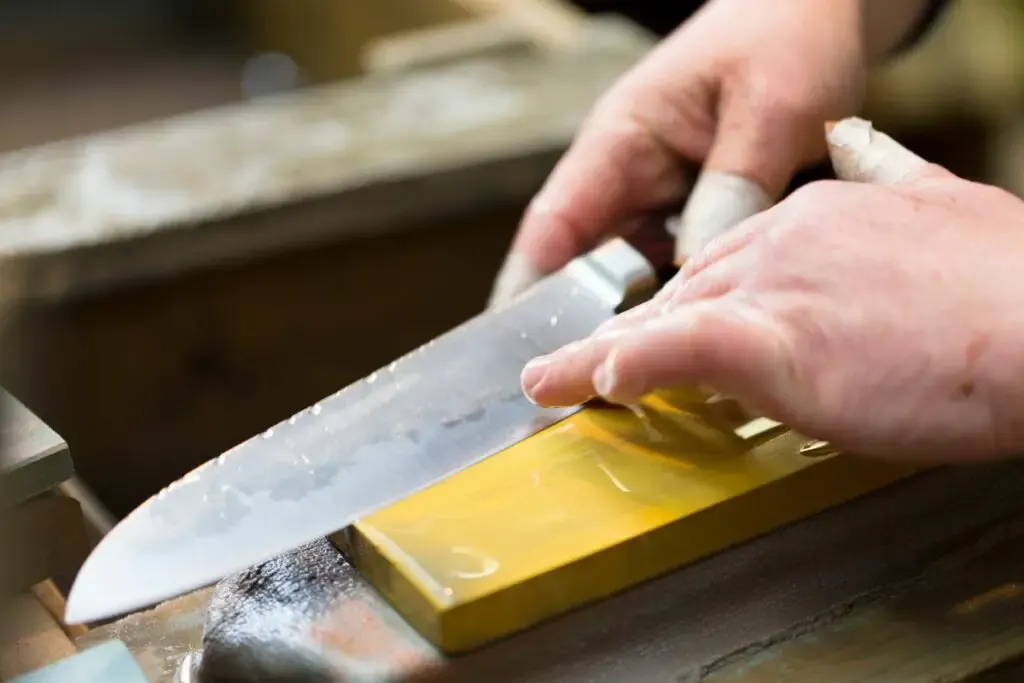
When it comes to maintaining the sharpness and longevity of your knives, the method of sharpening you choose plays a pivotal role. Among various methods available, whetstones have long been revered for their effectiveness and precision.
Is it worthwhile to invest time and effort in learning to use whetstones? The answer is a resounding yes, and here’s why:
Unparalleled Sharpness and Precision
Whetstones offer a level of sharpness and precision that is hard to achieve with manual or electric sharpeners. The process of sharpening on a whetstone allows for a more controlled and gradual honing of the knife’s edge.
This results in a sharper, more refined edge that not only cuts better but also retains its sharpness longer. For anyone who values the quality of their cutlery, this alone makes whetstones an invaluable tool.
Versatility for Different Knives
Different knives, from kitchen blades to hunting knives, require different sharpening angles and techniques. Whetstones provide the versatility needed to accommodate these variations.
With a range of grits available, whetstones can be used to sharpen virtually any knife, whether it’s repairing a damaged edge with a coarse grit or achieving a razor-sharp finish with a finer grit.
Gentle on Knives
Unlike some mechanical sharpeners that can be harsh and remove more material than necessary, whetstones offer a gentler approach. This not only preserves the integrity of the blade but also extends its lifespan.
Over time, this gentle yet effective sharpening method can save you money by reducing the need for frequent knife replacements.
Skill Development and Satisfaction
Learning to use a whetstone is not just about maintaining your knives; it’s also about developing a skill that can be both satisfying and meditative. The process of sharpening a knife on a whetstone requires patience and attention, which can be a rewarding experience in itself.
There’s a sense of accomplishment in restoring a dull blade to its former glory using your own hands and skill.
Environmental and Economic Benefits
Whetstones, unlike electric sharpeners, do not require power, making them a more environmentally friendly option.
Additionally, a good quality whetstone can last for years, making it a cost-effective investment in the long run, especially when compared to the recurring costs of replacing cheaper sharpeners or professional sharpening services.
Tailored Sharpening Experience
Every knife and its user are unique, and whetstones allow for a tailored sharpening experience. You can adjust the angle and pressure to suit the specific blade and your personal preference, something that is not possible with pre-set angles in manual or electric sharpeners.
While there is a learning curve to using whetstones, the benefits they offer in terms of sharpness, precision, versatility, and knife longevity make it a skill worth acquiring.
For anyone serious about their knives and the quality of their cut, mastering the use of whetstones is not just a choice but a necessary step in the journey of knife ownership and care.
Conclusion
There is no doubt that whetstones are the best sharpening method for knives, but it takes time and patience to master this skill.
If you only have pocket knives or bushcraft knives, manual sharpeners may be an easier alternative, and electric sharpeners for general kitchen knives.
For high-end kitchen knives, establishing an extremely sharp, long-lasting edge and a professional finish, there is no substitute for whetstone sharpening. Learning the rewarding skill of sharpening knives on a whetstone is well worth the effort.
TIP: Sharpening knives is a skill that requires practice and experience to create the perfect edge on your knives. Or you can sharpen your knives by a professional service. Find out more in the article below:
Get Your Knives Sharpened Professionally: Why, Costs & How Often

